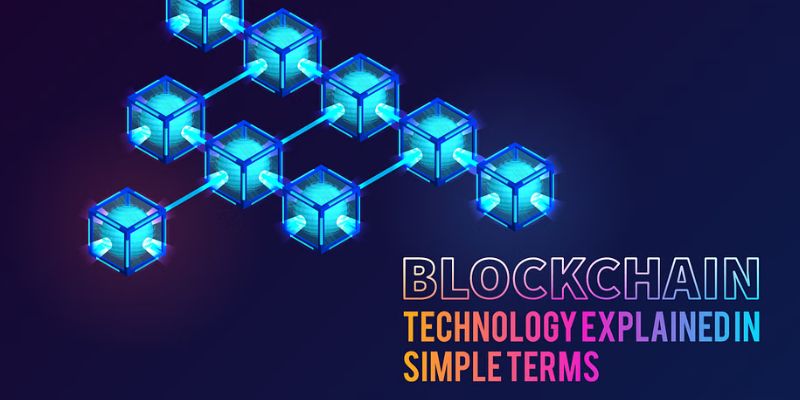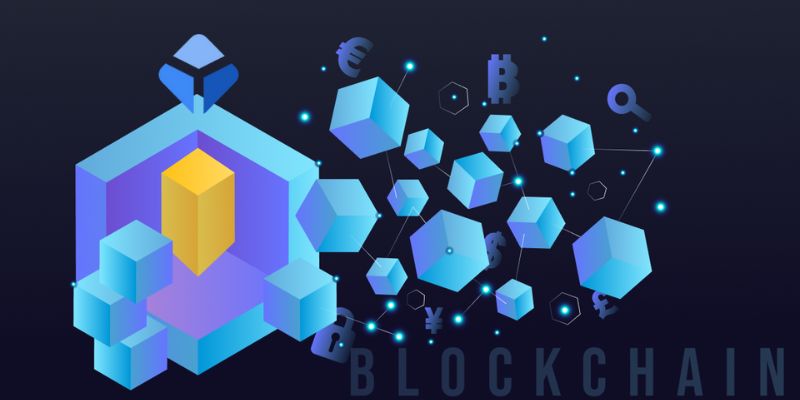Ever wondered how blockchain makes digital trust a reality? Get ready to dive into the Explanation of blockchain technology. Today, you’ll learn how this tool changes the game for securing data and assets. Think of blockchain as a digital ledger that’s both open and secure. Odd combo, right? But it works. We’ll start by breaking down its core elements- the ones that give hackers a hard time. Then, we move on to the nuts and bolts- the operations that keep it running smooth. Along the way, we’ll see how different sectors are scoring wins with blockchain. Finally, we’ll tackle the brainy debates and hefty challenges steering its future. Ready to unlock the secrets of decentralized innovation? Let’s jump in!
Understanding the Foundations of Blockchain
Exploring the Principles and Components of Blockchain
Let’s dive into how blockchain works. Picture a digital chain of blocks. Each block holds a bunch of records. These blocks link with a secure code called a hash. This hash is like a fingerprint; it’s unique for every block.
These blocks form a chain because each new block has the hash of the one before it. This is blockchain! It’s a kind of memory lane for data that no one can mess with. It’s called ‘decentralized’ because no single person or group controls it. Instead, everyone who is part of the network helps keep it safe and up-to-date. Think of it as teamwork at its best!
Now, the blockchain is not alone. It lives and breathes on a network of computers, often called nodes. These nodes check the info and agree on what’s true. This agreement process is called consensus, and it’s vital. It stops cheating in the network.
Smart contracts live on the blockchain too. They are rules written in code. They work like a vending machine: If you do something right, you get a reward. If not, the contract waits for what’s needed.
Blockchain is like a super diary that’s tough to mess with. Once you write something in it, it’s pretty much there forever. This trait is called immutability. Data structure in blockchain is neat! It helps everyone believe the records are real and haven’t been changed.
The Role of Cryptography in Securing Blockchain Networks
Cryptography is a big word for secret codes. In blockchain, it’s like a lock and key for data. It keeps our stuff safe on the network. Think of it as a clubhouse with a secret knock. If the knock (or data) matches the secret pattern, you’re in! This is how blockchain keeps our money and messages private.
Benefits of our clubhouse? No one you don’t want can get in. This means our data and money stay safe. Blockchain uses a special math trick called hashing to make this work. Hashing scrambles data into a code. If you try to change the data, the hash code changes too. That’s how we know if someone’s been sneaking around our clubhouse!
Blockchain and security go hand in hand. Our secret codes need to be tough to crack. The codes use public keys, like an address anyone can see, and private keys, like a secret password only you know. This clever combo makes sure we can share info without worry.
Now a word on blockchain platforms and types. Some are like a private party, we call those permissioned. Others are an open house, called permissionless. The party type decides who can add blocks to the chain or see it.
We’ve learned some basic facts about blockchain now. It’s a mix of teamwork, private codes, and trust that can keep everything from money to messages secure. It’s being used in so many places, like fintech. That’s just finance with tech flair! And it’s just the start as we look to the future of this tech—a future that’s bright and promises to keep our digital world safe and honest.
The Mechanics of Blockchain Operations
Deciphering the Blockchain Transaction Process and Consensus Mechanisms
Think of blockchain as a digital ledger. It records info like a notebook. But not just one person owns this ledger. Many do, and they make sure all records match. They’re like detectives hunting for clues to keep the ledger true. This makes sure no one cheats. Each record is a block. They link together to form a chain. Hence, we call it blockchain.
Let’s look closer at how blockchain handles deals. When you send money to a friend, you start a transaction. This transaction must be okayed by others in the network. But, how does the network agree? They use rules, called consensus mechanisms, to check if transactions are good. One popular rule is Proof of Work. This rule asks network folks to solve tricky puzzles. Solving them proves the transactions true. Now, rewards go to those who solve puzzles first. This motivates them to maintain the ledger well.
Some people question this method though. They worry it uses too much power. So, another rule called Proof of Stake comes into play. Here, the more coins you hold, the more power you have to okay a transaction. This uses less energy. It depends on trust, not on puzzle-solving skills.
How Smart Contracts Function within Blockchain Platforms
Now, what about complex deals? That’s where smart contracts come in. Smart contracts are like robot helpers on the blockchain. They make sure rules of a deal are followed to the letter. Let’s say you want to buy a digital tune with crypto. The smart contract holds your coins first. Then, it checks every note and beat of the tune you chose. If the deal’s terms meet, the contract releases your coins. The singer gets the payment, and you get to rock out to your new jam.
Smart contracts don’t make mistakes. They don’t cheat. They follow what the deal says and nothing else. These contracts live on the blockchain, so they’re spread out. Everyone can see them work, but nobody can change them without everyone else knowing. It’s like a glass bank where you see everything happen, and it’s super secure.
We’re taking brave new steps with blockchain tech. It’s like the early days of the internet. Soon, we’ll use blockchain in more ways than we can guess. It will change the flow of money, how we vote, and keep our secrets. We’re still figuring it out, but blockchain is here to stay. It’s not just a fad, it’s a future. And we’re part of it, today and tomorrow.
The Impact of Blockchain Across Industries
Case Studies: Blockchain Implementation in Various Sectors
Take a dive into how blockchain changes game rules across sectors. Fields like finance, healthcare, and even art see big shifts with blockchain. Let’s unwrap success stories from each one.
In finance, blockchain shows its muscle in safety and speed. Like with Ripple, banks send money across borders quick and sure. It’s like mailing a letter but as fast as sending a text. This speed saves banks heaps of time and cash.
Healthcare jumps on the blockchain bandwagon, too. Patient records have a new pal in blockchain. It keeps their info safe and in one piece. With blockchains, doctors access a full record chain lightning-fast. No more messed-up or lost records.
Now, art may seem a world away from tech. Yet, blockchain brings a fresh breath here as well. Artists sell their work safe in the fact that blockchain will track it. Each art piece gets a special token, proving who made it and owns it. This cuts down fake copies and theft.
Predictions: The Future Trajectory of Blockchain Applications
Thinking ahead, blockchain’s future looks bright and busy. It’s not just a fad; it’s a tool that’ll likely touch our daily lives even more.
Here’s what we might see next:
For one, voting in elections could become more common with blockchain tech. It helps keep votes hidden yet true, so no bad play muddies the waters. It’s just honest voting made simple and safe.
Blockchain could also make sharing personal data safer on the web. Imagine you’re in control of who peeks at what you share or sell online. Blockchain could make this real and give power back to you.
Plus, we’re talking the start of a “smart property” era. Homes and cars get smarter with tech that says who owns what clear as day. This means fewer fights over who bought that car and when.
In short, blockchain’s a jack-of-all-trades, changing how we trade, keep safe, and say what’s ours. It’s not just for pros who know the trade. It’s baked into things we use each day, making life a bit less of a chore.
As we move forward, we’ll see blockchain blend into our world in ways big and small. And as it blends, it boosts how we keep things fair, fast, and in check. Now more than ever, we’re set to ride a wave of change – all thanks to blockchain.
Advancing the Blockchain Ecosystem
Exploring the Debate: Proof of Work vs. Proof of Stake
Let’s dig into how we keep our blockchain safe and fair. You know, it’s like a game, where we have rules to make sure no one cheats. These rules are called consensus mechanisms. They’re super important for our blockchain to work right.
So, what’s Proof of Work (PoW)? It’s a way to prove that someone did a bunch of computer work to create a new block – think of it as a math puzzle. It’s not just any puzzle, though; it’s so tough that many computers compete to solve it. The first one to do it gets to add a new page to our blockchain book and gets some digital coins for their hard work. But this takes a lot of energy – like leaving all the lights on at home, all the time.
Now, what about Proof of Stake (PoS)? Imagine you’ve got a big piggy bank full of coins. In PoS, if you show you’ve got a lot of coins saved up – like, really a lot – you get a chance to add to our book. You don’t need to solve tough puzzles, so it saves a ton of energy. Plus, because you have so much money in the game, you don’t want to mess up; otherwise, you could lose it.
Both PoW and PoS are ways to make sure everyone agrees on what’s written down in our booklet without needing someone to watch over. It’s our high-tech secret handshake. But people fight over which one is better just like how we argue about superhero powers. Some say PoW is stronger – it’s been around longer and powers a big coin called Bitcoin. Others say PoS is smarter – it’s like having a guard who’s got a lot to lose if they goof up.
Addressing Challenges: Scalability and Governance in Blockchain Networks
Now, let’s talk about two big head-scratchers: making blockchain faster and who decides what.
Imagine our blockchain is a road. If too many cars get on it, we’ve got a traffic jam. That’s our scalability problem. We want our road to handle more cars without getting clogged. There are super-smart people working on this right now. They’re making new roads and even superhighways in our blockchain world so that we can zoom around without waiting.
And then, there’s governance. Think of it like the rules at school. Who gets to make the rules and how? In our blockchain, we need to decide who can change things and how we do it. It’s tricky because our blockchain is for everybody, and we don’t want just one person to call the shots. It’s all about making choices together and being cool with it.
So, we keep making our blockchain better – faster roads, fair rules. It’s a bit like a big group project where we’re always thinking of new ways to make it work for everyone. We’re all in it together. This is what’s so exciting about blockchain – we’re like pioneers in a brand new world, and you’re part of it!
We’ve covered a lot in exploring blockchain’s core, how it works, its broad impact, and future. We started by digging into blockchain basics, looking at its parts and the key role of cryptography. Next, we broke down how transactions occur and how smart contracts streamline processes. We saw real blockchain uses in different sectors and made educated guesses on where it’s all heading. Finally, we debated Proof of Work versus Proof of Stake and tackled hurdles like scaling and managing these networks.
My final thoughts? Blockchain is more than just tech buzz; it’s a game changer across the board. Sure, there are challenges, but the potential for innovation and improvement is massive. Keep an eye on this space – the future is unfolding right before us, one block at a time.
Q&A :
What is blockchain technology and how does it work?
Blockchain technology is the backbone of cryptocurrencies like Bitcoin and Ethereum. It works like a digital ledger that records all transactions across a network of computers. This ensures that each transaction is secure and tamper-resistant, as the data is not stored in a single location and is accessible to all participants, making tampering difficult.
Why is blockchain considered to be secure and tamper-proof?
The security of blockchain comes from its use of decentralization and cryptographic hashing. Each block in the chain contains a unique hash, as well as the hash of the previous block. Any alteration to the data would change the hash and break the chain, alerting the network to potential fraud. Additionally, majority consensus is needed to validate new entries.
How does blockchain technology benefit businesses?
Blockchain technology offers numerous benefits to businesses, including reduced transaction costs, enhanced security, improved traceability, increased efficiency, and the automation of processes through smart contracts. These advantages are leading many industries to explore blockchain-based solutions for supply chain management, financial services, and more.
Can blockchain be used beyond cryptocurrencies?
Yes, blockchain has a wide range of applications beyond cryptocurrencies. It’s being explored in fields such as supply chain management, healthcare, voting systems, real estate, and identity verification, among others. The technology’s ability to maintain transparent and secure records makes it appealing for various business processes and transactions.
How will blockchain technology evolve in the future?
The future of blockchain technology is likely to see an expansion in its application areas, improvements in scalability and interoperability between different blockchains, and the development of more user-friendly interfaces. With ongoing research and innovation, blockchain has the potential to revolutionize how we interact with digital systems on a societal level.


